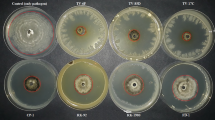Abstract
We evaluated the biocontrol efficacy of a Bacillus subtilis strain isolated from symptomless olive leaves against the olive knot disease pathogen Pseudomonas savastanoi pv. savastanoi. Bacillus subtilis F1 and F-4 displayed antibacterial activity against the pathogen. In planta, only B. subtilis F1 significantly reduced the weight of knots caused by P. savastanoi pv. savastanoi IVIA 1628 and Aw9, whereas copper treatment was effective only when using strain Aw9, thus a reduction of 50% was obtained. Preliminary characterisation of the active compound produced by B. subtilis F1 showed that it was proteinaceous in nature. These results suggest that B. subtilis strain F1 could be used to control, and prevent infection by, the causal agent of olive knot disease.




Similar content being viewed by others
References
Acea MJ, Moore CR, Alexander M (1988) Survival and growth of bacteria introduced into soil. Soil Biol Biochem 20:209–515
Ahimoua F, Jacquesb P, Deleua M (2000) Surfactin and iturin A effects on Bacillus subtilis surface hydrophobicity. Enzyme Microb Technol 27:749–754
Baker CJ, Stavely JR, Mock N (1985) Biocontrol of bean rust by Bacillus subtilis under field conditions. Plant Dis 69:770–772
Ercolani GL (1978) Pseudomonas savastanoi and other bacteria colonizing the surface of olive leaves in the field. J Gen Microbiol 109:245–257
Ercolani GL (1991) Distribution of epiphytic bacteria on olive leaves and the influence of leaf age and sampling time. Microb Ecol 21:35–48
Kacem M, Kazouz F, Merabet C, Rezki M, De Lajudie P, Bekki A (2009) Antimicrobial activity of Rhizobium sp. strains against Pseudomonas savastanoi, the agent responsible for the olive knot disease in Algeria. Grasas Aceites 60:139–146
Krid S, Rhouma A, Queseda JM, Penyalver R, Gargouri A (2009) Delineation of P. savastanoi pv. savastanoi strains isolated in Tunisia by ramdom-amplified polymorphic DNA analysis. J Appl Microbiol 106:886–894
Lavermicocca PS, Lonigro L, Valerio F, Evidente A, Visconti A (2002) Reduction of olive knot disease by a Bacteriocin from Pseudomonas syringae pv. ciccaronei. Appl Environ Microbiol 68:1403–1407
Leifert C, Li H, Chidburee S, Hampson S, Workman S, Sigee D, Epton HAS, Harbour A (1995) Antibiotic production and biocontrol activity by Bacillus subtilis CL27 and Bacillus pumilus CL45. J Appl Bacteriol 78:97–108
Liu YF, Chen Z, Ng TB, Zhang J, Zhou M, Song F, Lu F, Liu Y (2007) Bacisubin, an antifungal protein with ribonuclease and hemagglutinating activities from Bacillus subtilis strain B-916. Peptides 28:553–559
Merriman PR, Price RD, Kollemogen JF, Piggott T, Ridge EH (1974) Effect of seed inoculation with Bacillus subtilis and Streptomyces griseus on the growth of cereals and carrots. Aust J Agric Res 25:219–226
PalBais H, Fall R, Vivanco JM (2004) Biocontrol of Bacillus subtilis against infection of arabidopsis roots by Pseudomonas syringae is facilitated by biofilm formation and surfactin production. Plant Physiol 134:307–319
Rajkumar M, Lee WH, Lee KJ (2005) Screening of bacterial antagonists for biological control of Phytophtora blight of pepper. J Basic Microbiol 45:55–63
Ran LX, Liu CY, Wu GJ, Van Loon LC, Bakker PAHM (2005) Suppression of bacterial kilt in Eucalyptus urophylla by fluorescent Pseudomonas spp. in China. Biol Control 32:111–120
Rhouma A, Bouri M, Boubaker A, Nesme X (2008) Potential effect of rhizobacteria in the management of crown gall disease caused by Agrobacterium tumefaciens. J Plant Pathol 90:517–526
Rodríguez-Moreno L, Jiménez AJ, Ramos C (2009) Endopathogenic lifestyle of Pseudomonas savastanoi pv. savastanoi in olive knots. Microb Biotechnol 2:476–488
Rokni ZH, Khavazi K, Asgharzadeh AM, De Mot HR (2008) Biocontrol of Pseudomonas savastanoi pv. savastanoi, causative agent of olive knot disease: antagonistic potential of non-pathogenic rhizosphere isolates of fluorescent Pseudomonas. Commun Agric Appl Biol Sci 73:199–203
Saravanakumar D, Vijayakumar C, Kumar N, Samiyappan R (2007) PGPR-induced defence responses in the tea plant against blister blight disease. Crop Protect 26:556–565
Scherm H, Ngugi HK, Savelle AT, Edwards JR (2004) Biological control of infection of blueberry flowers caused by Monilinia vaccinii-corymbosi. Biol Control 29:199–206
Schroth MN, Hildebrand DC, O’Reilly HJ (1968) Off-flavor of olives from trees with olive knot tumors. Phytopathology 58:524–525
Schroth MN, Osgood JW, Miller TD (1973) Quantitative assessment of the effect of the olive knot disease on olive yield and quality. Phytopathology 63:1064–1065
Sharma N, Sharma S (2006) Control of foliar diseases of mustard by Bacillus from reclaimed soil. Microbiol Res 163:408–413
Shoda M (2000) Bacterial control of plant diseases. J Biosci Bioeng 89:515–521
Someya N (2008) Biological control of fungal plant diseases using antagonistic bacteria. J Gen Plant Pathol 74:459–460
Stelle JM, Vlami M, de Souza JT (2002) Antibiotic production by bacterial biocontrol agents. Antonie van Leeuwenhoek 81:379–407
Stonier T (1960) Agrobacterium tumefaciens ConnII. Production of an antibiotic substance. J Bacteriol 79:889–898
Surico G (1986) Indoleacetic acid and cytokinins in the olive knot disease. An overwiew of their role and their genetic determinants. NATO ASI series. Series H: cell biology, vol 1. Springer, Berlin, pp 315–329
Tagg JR, McGiven AR (1971) Assay system for bacteriocins. Appl Microbiol 21:943
Turner JT, Backman PA (1991) Factors relating to peanut yield increases after seed treatment with Bacillus subtilis. Plant Dis 75:347–353
Vidaver AK (1976) Prospects for control of phytopathogenic bacteria by bacteriophages and bacteriocins. Annu Rev Phytopathol 14:465–541
Whipps JM (2001) Microbial interaction and biocontrol in rhizosphere. J Exp Bot 52:485–511
Wilson M, Hirano SS, Lindow SE (1999) Location and survival of leaf-associated bacteria in relation to pathogenicity and potential for growth within the leaf. Appl Environ Microbiol 65:1435–1443
Zhang JX, Xue AG (2010) Biocontrol of sclerotinia stem rot (Sclerotinia sclerotiorum) of soybean using novel Bacillus subtilis strain SB24 under control conditions. Plant Pathol 59:382–391
Acknowledgements
This work was supported by the funds of Institut de l’Olivier and Centre de Biotechnologie de Sfax, Tunisia.
Author information
Authors and Affiliations
Corresponding author
Rights and permissions
About this article
Cite this article
Krid, S., Triki, M.A., Gargouri, A. et al. Biocontrol of olive knot disease by Bacillus subtilis isolated from olive leaves. Ann Microbiol 62, 149–154 (2012). https://doi.org/10.1007/s13213-011-0239-0
Received:
Accepted:
Published:
Issue Date:
DOI: https://doi.org/10.1007/s13213-011-0239-0




